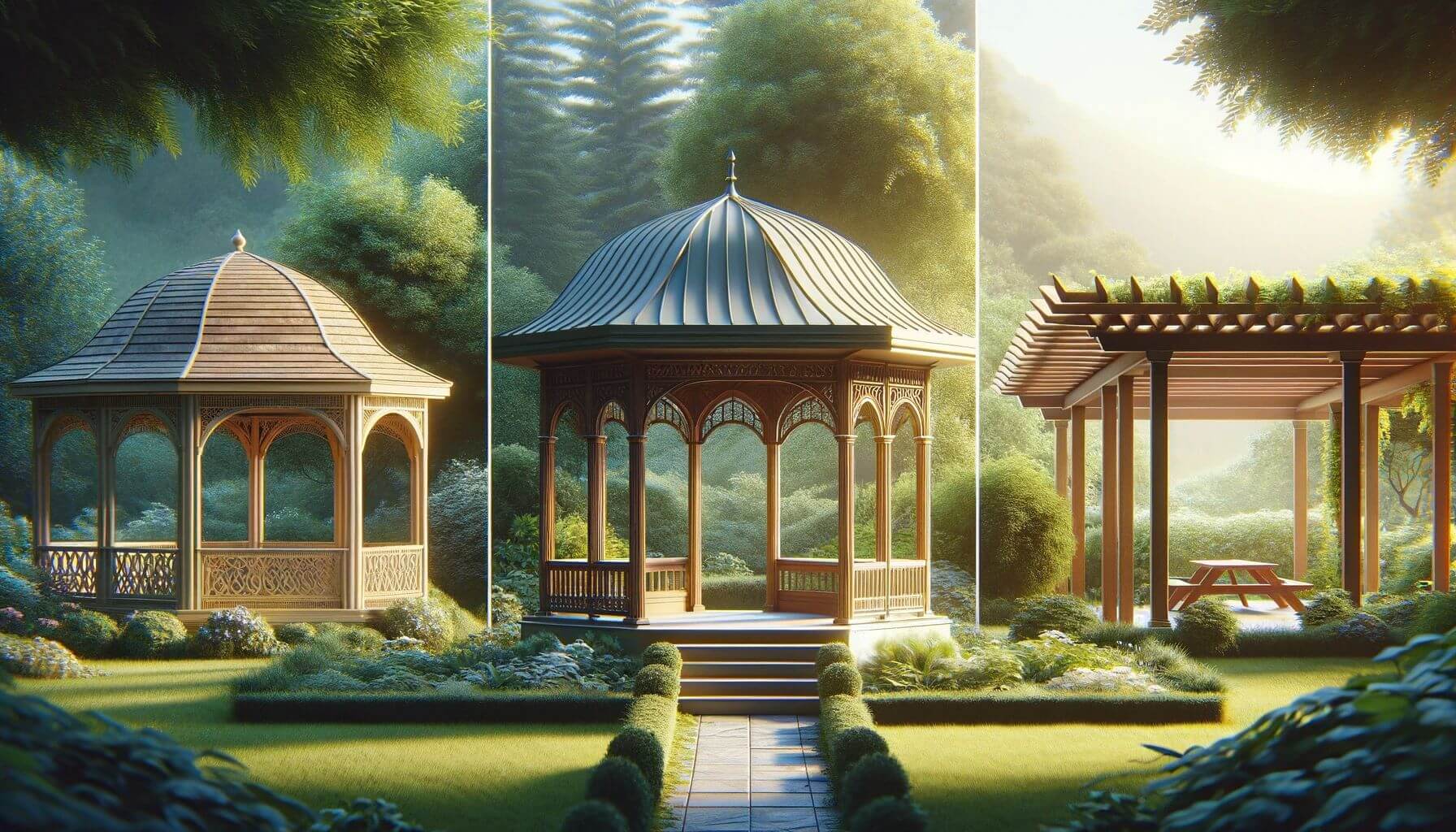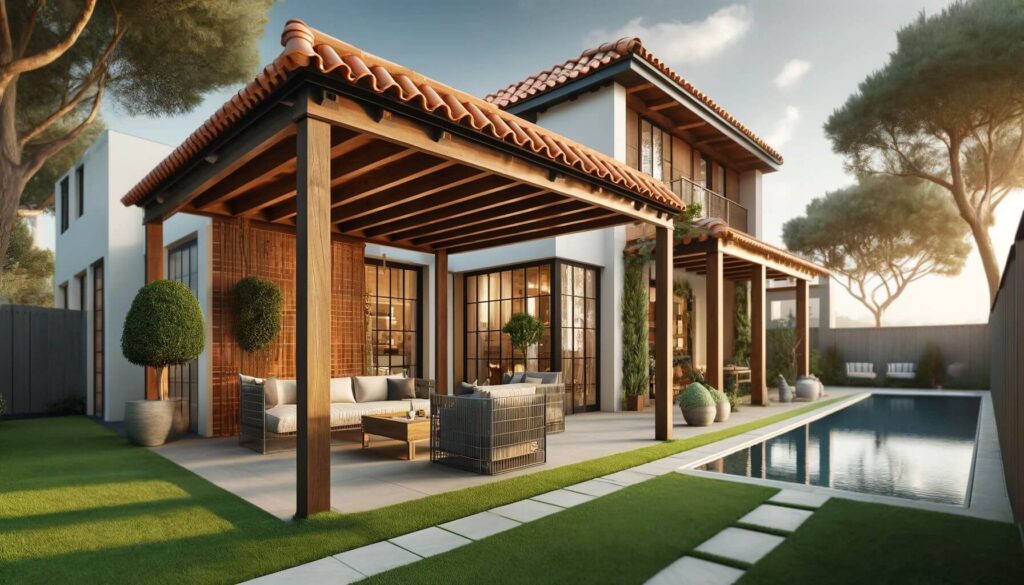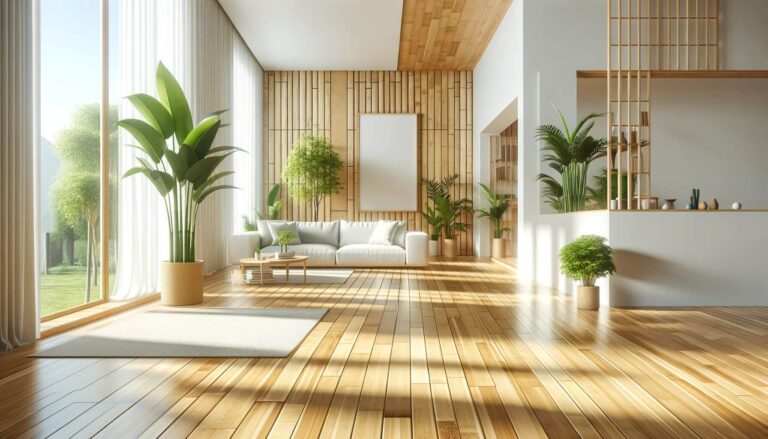
Choosing the right structure for your outdoor space is more than just an aesthetic decision; it’s a functional one that impacts how you enjoy your backyard or garden. Gazebos, pavilions, and pergolas each offer unique advantages and can drastically enhance the usability and appearance of your outdoor areas. We will dive into the specifics of each to help you decide which structure best suits your needs, blending seamlessly with your outdoor decor while fulfilling your functional requirements.
What is a Gazebo?
Definition and Design
A gazebo is a stand-alone structure, typically octagonal or turret-shaped, that adds a touch of elegance to outdoor spaces. Crafted from materials like wood, metal, or vinyl, gazebos are versatile in style and functionality.
Common Features
Gazebos are known for their solid roofs and optional screened windows, which offer shelter against the elements while providing a panoramic view of the surroundings. Many designs include built-in seating, enhancing comfort and making them a cozy place for relaxation.
Pros and Cons
Pros:
- Shelter and Style: Gazebos provide robust shelter from sun and rain and are often seen as a decorative focal point in a garden.
- Enhanced Comfort: The inclusion of screens and built-in seating options make gazebos a luxurious spot for relaxation.
Cons:
- Cost: High-quality materials and intricate designs make gazebos a pricier option compared to other outdoor structures.
- Space Requirements: Gazebos require a significant amount of space, making them less suitable for smaller yards.
Ideal Uses
Gazebos excel in aesthetic appeal and functionality. They are perfect for:
- Gardens: Enhances the beauty of garden spaces with a picturesque structure.
- Relaxation Spots: Offers a sheltered outdoor area to relax, read, or enjoy a quiet cup of coffee.
- Intimate Gatherings: Provides a private, sheltered space for family gatherings or small social events.
What is a Pavilion?
Definition and Design
A pavilion is an open-sided, rectangular structure often used in public spaces and private yards. This architectural feature is typically larger than other outdoor structures and made from durable materials like wood or metal, which help withstand various weather conditions.
Common Features
Pavilions feature a solid roof but no walls, which creates a breezy, shaded area for outdoor activities. The spacious interior is ideal for accommodating furniture and large groups, making it a versatile addition to any space.
Pros and Cons
Pros:
- Versatility: The open design accommodates various uses, from outdoor dining to social gatherings.
- Spacious: Large size is perfect for hosting events or adding substantial covered space to a property.
Cons:
- Limited Insect Protection: Without walls, pavilions offer little protection from insects, which can be a drawback in certain climates.
- Exposure to Elements: The lack of walls means less shelter from wind and rain, although the roof provides significant overhead protection.
Ideal Uses
Pavilions are especially suited for:
- Large Social Events: Their size and open design make them ideal for weddings, family reunions, and other big gatherings.
- Dining Areas: Perfect for setting up an outdoor kitchen or a picnic area, providing shelter while enjoying meals outside.
- Outdoor Kitchens: Can be equipped with various amenities for outdoor cooking and dining, enhancing any culinary experience in the fresh air.
What is a Pergola?

Definition and Design
A pergola is an outdoor garden feature forming a shaded walkway, passageway, or sitting area of vertical posts or pillars that usually support cross-beams and a durable open lattice, often upon which woody vines are trained. It can be made from wood, metal, or vinyl and is celebrated for its ability to integrate organically with the landscaping.
Common Features
Unlike gazebos and pavilions, pergolas are designed to support climbing plants, creating a natural canopy of greenery. They typically have an open roof structure that allows light to filter through, enhancing the natural ambiance. The structure serves not only as a functional area for relaxation but also as an aesthetic element in garden design.
Pros and Cons
Pros:
- Aesthetic Appeal: Adds a romantic, pastoral charm to any outdoor setting.
- Customizable: Easily adaptable to different styles and sizes to fit various landscapes.
- Plant Integration: Ideal for growing climbing plants like vines, roses, and ivy, which can provide additional shade and privacy.
Cons:
- Minimal Weather Protection: The lattice roof does not offer significant shelter from rain or sun.
- Maintenance: Requires regular maintenance, especially if used to support plants that can overgrow or damage the structure if not properly cared for.
Ideal Uses
Pergolas are perfect for:
- Garden Paths: Creating beautiful, vine-covered walkways that enhance the natural landscape.
- Patio Covers: Offering partial shade over patios, making them more usable throughout the day.
- Enhanced Landscaping: Introducing vertical gardening elements and improving the overall aesthetic of garden spaces.
Head-to-Head Comparisons
Difference Pavilion vs. Pergola
Space Usage:
- Pavilions offer a vast, unobstructed space ideal for large gatherings and can be equipped with large tables and plenty of seating. Pergolas, while also providing space flexibility, are more suited to intimate settings and decorative purposes with their column-supported design allowing for open, airy layouts.
Aesthetic in Landscapes:
- Pavilions have a more robust and sheltered build, making them standout features in a landscape. They work well in both rustic and modern garden designs. Pergolas, with their lattice framework, offer a delicate, intricate look that integrates seamlessly with the surrounding greenery, enhancing garden aesthetics with a natural, earthy feel.
Level of Protection from Elements:
- Pavilions, with their enclosed roofs, provide substantial protection from sun and rain, making them suitable for all types of weather. Pergolas, on the other hand, offer limited protection; their slatted roofs are best for areas with milder climates unless additional coverings are added.
What is the Difference Pergola vs Gazebo
Garden Integration Gazebo vs Pergola:
- Pergolas blend naturally with landscaped gardens, using climbing plants and natural materials to enhance the garden’s aesthetic. Gazebos are often the focal point of a garden, with a more structured and possibly ornate design that can complement any garden style.
Privacy Features Pergola vs Gazebo :
- Gazebos typically offer more privacy due to the option of fitted screens or draped curtains along their sides. Pergolas, with open sides and climbing plants, provide partial privacy that is less about seclusion and more about integrating with the environment.
Typical Uses:
- Pergolas are ideal for creating shaded pathways or covering sections of a garden, enhancing the landscape without overwhelming it. Gazebos serve as private retreats or entertainment spaces, often equipped with seating and built to accommodate groups, making them perfect for more social and family-oriented activities.
Gazebo or Pavilion
Capacity Outdoor Pavilion & Gazebo:
- Pavilions, generally larger, are designed to cover more ground and accommodate more people, ideal for public spaces or events. Gazebos are typically smaller, providing a quaint, intimate setting suitable for groups of a few individuals.
Formal Appeal Gazebo vs Pavilion:
- Gazebos have a traditional charm and are often used in formal garden settings or for specific purposes like weddings. Pavilions, with their simple yet sturdy structure, offer a more casual formality that is adaptable to various events and gatherings.
Versatility for Events Pavilion vs Gazebo:
- Pavilions are extremely versatile due to their open and spacious nature, suitable for multiple types of events from family reunions to large outdoor banquets. Gazebos, while versatile, are better suited for smaller, more intimate gatherings and can be limited by their enclosed design and smaller footprint.
Factors to Consider When Choosing Pavilion vs Gazebo vs Pergola
Purpose and Functionality of Gazebo vs Pergola vs Pavilion
Entertainment Needs:
- Pavilions are optimal for large-scale events and gatherings, offering ample space without the constraints of walls.
- Gazebos provide a picturesque setting suitable for smaller, more intimate gatherings or quiet personal retreats.
- Pergolas are perfect for decorative purposes, enhancing garden pathways or creating natural, shaded areas that invite leisurely time outdoors.
Privacy Pergola vs Pavilion:
- Gazebos, with the option to install screens or curtains, offer the best privacy among the three, making them ideal for enclosed personal or family spaces.
- Pergolas allow for semi-private spaces, which can be increased by the growth of climbing plants.
- Pavilions, though open and airy, can be modified with drapes or other temporary fixtures to enhance privacy.
Landscape Integration:
- Pergolas offer the highest level of integration with a garden, particularly with landscaped or floral backdrops.
- Gazebos and pavilions also complement a well-planned garden but are more standalone features and require thoughtful placement to harmonize with existing landscape designs.
Budget Considerations
Cost Implications:
- Gazebos tend to be more expensive due to detailed craftsmanship and the potential for intricate designs and durable materials.
- Pavilions might cost less per square foot but can become more expensive overall due to larger sizes.
- Pergolas are generally the most cost-effective, though prices can rise depending on material choice and design complexity.
Maintenance Requirements:
- Wood structures generally require more maintenance such as staining and sealing compared to metal structures, which are more durable and resistant to elements.
- Vinyl options offer ease of maintenance and durability, often at a higher initial cost but lower long-term care requirements.
Space and Location
Size of the Available Space:
- Pavilions require a significant amount of space and are best for large, open areas.
- Gazebos are more flexible in terms of placement and size but still need enough room to accommodate their design and functional usage.
- Pergolas, adaptable in size and shape, can be installed in varied spaces, making them suitable for both spacious and more confined areas.
Structure’s Footprint:
- Consider the base area each structure will cover. Pavilions might take up more ground space, which is essential to plan for during the landscaping phase.
- Gazebos and pergolas offer more flexibility in footprint, allowing for adjustments based on available space and intended use.
Climate and Environment
Local Climate:
- In areas with heavy rain or snow, gazebos with their enclosed roofs provide the best protection.
- Pergolas with an open lattice roof are suitable for milder climates unless adapted with an additional cover for protection.
- Pavilions, designed with a solid roof, are effective in various weather conditions but may require additional side protections depending on the environment.
Seasonal Use:
- Consider whether the structure will be used year-round or seasonally. Structures like gazebos and pavilions are more durable against harsher weather, making them suitable for all-year use.
- Pergolas might need seasonal adjustments such as removable covers or temporary weatherproofing enhancements.
Durability Against Elements:
- Assess the materials’ resistance to local weather conditions. Metal and vinyl offer high durability, whereas wood may need more frequent treatments to maintain its condition and appearance.
Making the Decision
Comparative Analysis Gazebo vs Pavilion vs Pergola
To aid in your decision, here’s a concise summary chart detailing the features, costs, and ideal uses of gazebos, pavilions, and pergolas:
| Feature | Gazebo | Pavilion | Pergola |
|---|---|---|---|
| Design | Octagonal, closed roof, screens | Open sides, rectangular, large | Open lattice, supports vines |
| Material | Wood, metal, vinyl | Wood, metal | Wood, metal, vinyl |
| Cost | High | Medium to high | Low to medium |
| Maintenance | Moderate to high | Low to moderate | Moderate |
| Best for | Intimate gatherings, gardens | Large events, open spaces | Decorative, garden paths |
| Privacy | High (with screens) | Low | Moderate (with plants) |
| Weather Protection | High | Moderate | Low |
| Size Requirements | Medium to large yard | Large yard | Flexible |
| Aesthetic | Traditional, formal | Casual, versatile | Natural, integrated |
Expert Advice
Consulting with landscape architects or builders can provide tailored advice based on your specific conditions. Experts can help assess environmental factors, spatial dynamics, and aesthetic considerations to ensure the chosen structure complements your outdoor space effectively. They can also offer insights into the best materials and configurations for durability and maintenance ease.
Personal Preference
Ultimately, the choice between a gazebo, pavilion, and pergola comes down to personal preference and lifestyle needs:
- Gazebos are ideal for those looking for a traditional, sheltered outdoor retreat suitable for all weather conditions.
- Pavilions appeal to those who need a spacious, versatile shelter for large gatherings and versatile use throughout the year.
- Pergolas are best suited for garden lovers who enjoy a blended indoor-outdoor feel and the beauty of climbing plants.
When selecting your outdoor structure, consider how each option would serve your entertainment needs, fit into your garden landscape, and meet your privacy requirements. Reflect on the long-term functionality and maintenance to ensure that your choice not only adds value but also enhances your living quality and enjoyment of your outdoor space.
When to Choose Pavilion vs Gazebo vs Pergola
In conclusion, whether you choose a gazebo, pavilion, or pergola depends on various factors, including the intended use, aesthetic preferences, climate considerations, and available space. Each structure offers unique benefits that can enhance your outdoor living experience:
- Gazebos provide a private, sheltered space ideal for small gatherings and intimate settings. Their enclosed design offers excellent protection from the elements, making them a perfect year-round addition to any garden.
- Pavilions are best suited for larger spaces and events, offering a versatile, open area that can be customized for different functions. With their robust construction, pavilions cater well to those who entertain frequently or require a flexible, spacious outdoor structure.
- Pergolas, with their open lattice roofs, offer a charming blend of shade and sunlight, perfect for those who appreciate a natural aesthetic. They are particularly fitting for enhancing landscapes and providing a supportive structure for climbing plants, adding both beauty and function to gardens.
When deciding between these options, weigh the pros and cons of each in relation to your specific needs and conditions. Consider not only the initial cost and maintenance but also how well each structure will integrate into your existing landscape. Consult with experts, consider your long-term needs, and choose a structure that will delight and serve you for years to come.
By carefully considering each aspect and how it aligns with your outdoor living goals, you can select the ideal structure that not only meets your practical needs but also complements your outdoor space beautifully. Whether for relaxation, entertainment, or aesthetic enhancement, the right choice will bring continual pleasure and functionality to your garden or yard.



